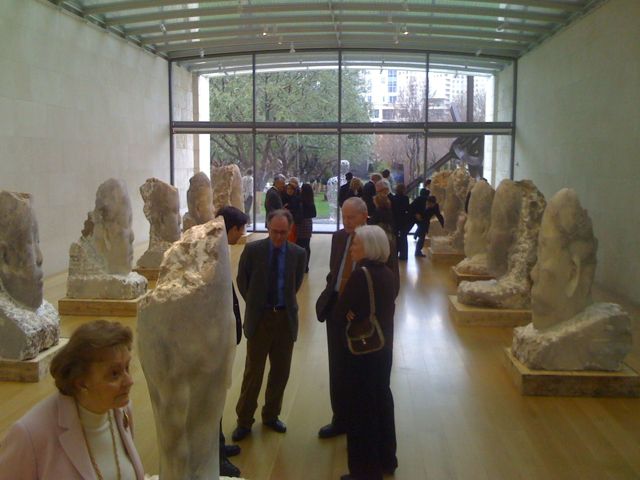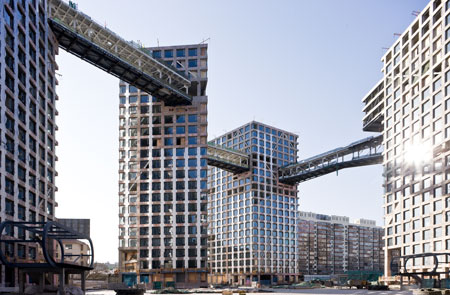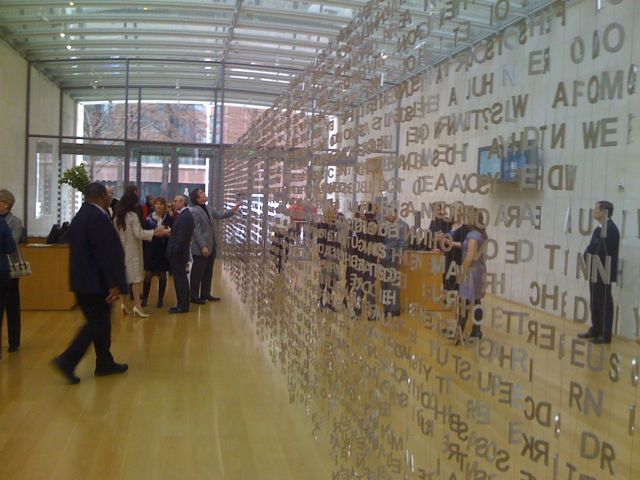Late yesterday afternoon, I learned that Darryl Beeson passed away. Darryl was involved in a car accident a few weeks ago and died from unspecified complications. Today on SideDish, his long-time friend and Savor Dallas co-founder Jim White remembers Darryl.
FrontBurner
 When the GOP gubernatorial debate was finished last night  at Belo’s WFAA-TV in Dallas, the 40 or 50 journalists who’d been watching the show backstage from a “media viewing area” were invited to file into the Channel 8 lobby, where featured performers Gov. Rick Perry, Sen. Kay Bailey Hutchison and Debra Medina had been asked to attend a post-debate press conference.Â
When the GOP gubernatorial debate was finished last night  at Belo’s WFAA-TV in Dallas, the 40 or 50 journalists who’d been watching the show backstage from a “media viewing area” were invited to file into the Channel 8 lobby, where featured performers Gov. Rick Perry, Sen. Kay Bailey Hutchison and Debra Medina had been asked to attend a post-debate press conference.Â
Pretty soon, though, word filtered into the lobby  that Perry wouldn’t be showing up. Then came news that Hutchison wouldn’t, either. Only Medina (pictured) stepped to the podium, claiming a “strong” debate performance and ripping her opponents for their absence at the after-party.Â
Medina was right about performing strongly in the statewide debate–she outdid Hutchison, for sure–but I’d say the night’s real winner was Perry. In contrast to the public-TV debate held earlier this month, when he came off oily and shallow, last night’s Perry was sharp, composed and commanding, downright statesmanlike. The turnaround was enough to etch his frontrunner status in the race in stone, I’d bet, and by the time the evening was over the increasingly formidable Medina–surprisingly and against all odds– seemed a threat to overtake Kay.
Do you think you know the difference between a hand-harvested scallop and a U-10? Then you will want to enter the “I Scuba for Scallops” contest on SideDish. (Hi, Adam!)
When I spoke with him on the phone this morning, Irving Mayor Herbert Gears hadn’t heard about today’s Houston Chronicle report that Exxon Mobil is drawing up plans for a big corporate campus down near The Woodlands.
The news has led to speculation that the world’s biggest company may be looking to relocate its corporate headquarters away from Irving. Gears said he expects that if they were planning a move he would have been alerted to the possibility before it were reported in the media.
“I have not had any indications whatsoever that they’ve been thinking about moving their headquarters anywhere,” he said. “We certainly would be sad to lose them, but we’re going to do everything we can to make sure we prevent that.”
“I’ll make a call as soon as I get off here. I’ll call Rex [Tillerson, CEO of Exxon Mobil].”
A few of us have gathered at the Nasher this rainy afternoon to hear a talk given by Spanish artist Jaume Plensa, whose “Genus and Species” opens January 30. The Nasher is promoting it as their first exhibition by a living artist. Funny story: a Nasher employee who shall remain unnamed was ferrying Plensa around in his/her car earlier and accidentally ran a red light. Plensa made a joke about how it was almost the Nasher’s first exhibition of an artist killed by the museum.


Update: I’m sure Peter will be along in a minute to share some details about the brief speech that Plensa gave and about his art. But here’s my favorite part: Plensa concluded by saying, “I’d love for you to touch my art.” He said the same thing to a group at the museum last night. The notion is giving the guards at the Nasher fits. Because, as you know, you ain’t supposed to touch anything else there. They are afraid that people won’t know where to draw the line. One minute you’re caressing an alabaster Plensa head (first picture); the next minute, you’re engaged in some out-of-bounds frottage with one of those people high atop Borofsky’s Walking to the Sky. So bottom line (no sexual pun intended), if you get handsy with either Twin 1 or Twin II (second picture), and if a guard tells you stop, be sure to tell em that Plensa said it was copacetic.
There’s a great local quote in this morning’s story about John Edwards’ handlers scrambling to funnel hush money to Edwards’ mistress, Rielle Hunter. It evidently originated with Edwards’ old pal Fred Baron, the Dallas plaintiff’s lawyer and Democratic Party rainmaker who died in 2008:
Other distributions came from Edwards’ former campaign finance chairman Fred Baron, including a FedEx envelope of $1,000 and a note that read: “Old Chinese proverb: Use cash, not credit cards.”
The Dallas Theater Center opened its third production in their new home last Friday. The verdict? Give It Up is like MTV’s The Real World meets HBO’s Real Sex, only it all plays out more like a traditional musical comedy than a sex romp,” writes our theater critic David Novinski. You can expect more from David in the coming months. Now just a tease: his full review is after the jump.
1. I was going to comment on Dallas ISD’s proposed fix for four high schools that face possible closure by the state. They’ll create magnet programs at each of the campuses to attract students that could boost the test scores and graduation rates (the DISD board seems to know it’s about “the inputs.”) I was going to say that this solution sounds like a trick to beat the system. Then I read the final paragraph of the DMN piece: “In addition, state records show that all four schools would not have passed Texas’ academic standards if they did not get statistical help from the state. Various formulas allow for schools to pass the standards even if too many students flunk state tests.” So, since districts apparently have access to a magic calculator, is there really a state accountability system left to trick?
2. Would this middle school student have been arrested any place other than in the Park Cities? Without knowing exactly what the threat was, it’s hard to say. But can we all agree that Fox 4 needn’t have required poor Sophia Reza to stand in the rain last night, outside a closed school, to report on an incident that occurred last week? Let’s free TV reporters from the tyranny of the wholly unnecessary live shot.
3. I was a little amused by the billboard. I find the commercial a little icky. But it’s all pretty sophomoric.

Crime sucks. Especially when it happens to you (unless it’s funny). In the past three months, someone very close to me (literally and home proximity) has had their car broken into twice, parked in what is supposed to be a secure parking garage.
This is the economy, which is the construct of how we interact with each other, represented by the form of our city. when our city is so divergent, as to force people of all incomes to HAVE to own a car, which can be up to or greater than 40% of their netcome, just to participate in civilized society perhaps the instinct of some is to withdrawal from that particular brand of civilization.
The other negative effect parking places on a city is perception. Neither parking lots nor garages feel like safe places to be. No matter how much flood lighting is applied, whether they are safe or not is immaterial. They are perceived as unsafe, which means the reality becomes that they are unsafe. They create dead zones with few watchful public “eyes” protecting the public realm.
Lesson: Learn to walk a few blocks. You could probably use the exercise.Drawback: We already have too much parking in Dallas, so building new garages doesn’t really alleviate that problem, unless we do so in order to consolidate surface parking.
Lesson: Price parking so as to discourage driving.Drawback: Business is allergic to any kind of change and this does little to leverage the surplus of surface lots. Unless of course, we think the over-supply of surface parking means low rates for on-street parking, where the City would then create more on-street spaces (to generate more revenue). All of which would then drive prices too low for the private surface lots to stay in business, which they might then sell.Drawback 2 to Drawback 1: Some wishful thinking there.
Lesson: Surface parking lot owners don’t give a shit about the city.Drawback: Good luck fighting those political battles. Which brings me to option 3b:
Lesson: Surface parking lot owners don’t give a shit about the city.Drawback: Could be some short-term budget gaps due to lowering taxes on current businesses/residents.
We received at the office yesterday an invitation from a Florida-based PR firm to take a press trip to Dallas to visit the recently renovated Sheraton Dallas (the largest hotel in Texas, for those keeping score at home). Besides the fact that we were invited to take a press trip to our own city, there are a number of things about this invitation that I found entertaining. Jump for the itinerary that journalists from across the country will enjoy — along with my comments.
In the category of, “uh oh, know when to run away.” A principal of a British architecture firm goes all paternalistic and suggests, “let us make all decisions.”
The problem is that the majority of contemporary architects are merely sculptors who look at post-Katrina NOLA and Port-au-Prince as good news stories and a chance to experiment on the poor with their misguided self-indulgent visions. Do you want cities like this?



This is precisely where those exact people get all huffy and drag this into a simple debate about style, exclaiming that I would attempt to limit their brilliance with silly rules based on empiricism and proven regularities of urban economies and places. Once again, I am stylistically agnostic.
In a post entitled, “Gehry the Dinosaur,” I suggest that architects should actually be limited when it comes to city building and broader issues, at least until its proven they have some understanding of complex interactions and dynamics of cities, beyond “big bridge, big building, big big big.” Oedipus-turned-Edifice complex?
Although, it might seem that I am contradicting my own post on Representative Democracy on Design, the key is public engagement and education. Increased public awareness creates for a competition with the “credentialed professionals,” which ensures the progress of a field.
Many architects don’t like that however, because they know many of their experimentations will not fly. Only through a singular well-financed and misguided entity can they do so. In that vein, they construct an entire language that means nothing, and in effect create a self-defensive, retrenched in ivory tower cult. Seriously, transcribe Eisenmann or Mayne sometime. Their words literally have no meaning.
Or, perhaps it is currently just a British problem. Because while no doubt there still exists some vestigial remnants of the highway pigs at the trough and the Senators that oblige them, in our federal government. At least, today as I write this, the US federal government, HUD, has reached out to the CNU and asked for a list of all federal barriers to Smart Growth and Livable Communities. Hooray!
———————————————
Vancouver Sun has an article on micro-condos, complete with picture of one with a Murphy Bed. Once more cities are ready for this market, these will emerge. I have written at length (here, here, here, and here)about the Millennial demand bubble emerging that will drive a trade-off between personal space forgiven for more social space, amenities, sociability, and urbanity.
———————————————
Grist shows a graph from Architecture 2030 suggesting 75% of the built environment will be replaced by 2035. However, it should be noted that the author is mistaking this for normal in his assertion that “cities get remade more often than you think.” While it is true to some extent that cities are constantly molting, this particularly accelerated building life cycle is entirely an American phenomenon, symptomatic of the same issues that brought down the banking industry. Delivering cheap crap to the American consumer, removing building restrictions and code oversight, and promising forever growth.
Personal anecdote: I served as lead urban planner and designer on a project redeveloping nearly 100-acres of low-grade garden apartments. These were built in the 1960’s and were once a happpening, swinging singles area. Before they were torn down and the tenants were given money for relocation, there were families living in buildings where the ceiling joists were literally caving into the rooms, walls had rotted, etc.
If you think building materials and construction quality have gotten better, you would be wrong. Which is why Texas homebuilders lobbied a certain former governor very persuasively and effectively for removal of all liability from the homebuilder on the date of the purchase.
The next twenty years, suburban life ought to be pretty interesting when everybody’s new home literally starts melting.
If you want to REALLY think about sustainability in a deep, meaningful, and transformative way, start asking how we can finance buildings based on life-cycle costs/performance, particularly in fields where developers typically flip their buildings immediately or shortly after construction.
FYI, the building I lived in in Rome was several hundred years old and the particular unit I was renting was on the market for $1 million. Think about the ROI on that entire building.
——————————————-
Pittsburgh conducted a study regarding cost savings switching street lights to LEDs and the results are…illuminating. (sorry)
the city, which spends $4.2 million annually on electricity and streetlight maintenance, could save $1 million each year in energy costs and $700,000 in maintenance costs with LED lighting.
Lastly, TreeHugger on 6 cities that could go car-free. Frankly, I don’t care for the article, but chose it precisely to make this point. It discusses that there are many cities that have car-free zones, but aren’t fully car-free. I don’t think it is wise to make ANY entire cities car-free, unless of course, you are Venice and there really is no use for them. Incremental Car-Free or Car-Limited is the way to go, and ONLY once you have the density and scale in place first, at which to support it.







